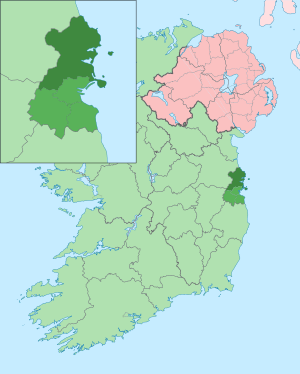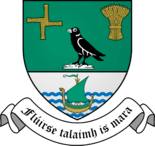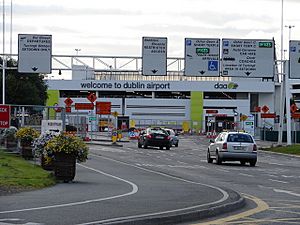Fingal facts for kids
Quick facts for kids
Fingal
Fine Gall
|
||
|---|---|---|
|
County
|
||
|
||
| Motto(s): | ||

Fingal (dark green) shown within County Dublin (light green) and within Ireland (lighter green)
|
||
| Country | Ireland | |
| Province | Leinster | |
| Region | Eastern and Midland | |
| Established | 1994 | |
| County town | Swords | |
| Area | ||
| • Total | 456 km2 (176 sq mi) | |
| Highest elevation | 176 m (577 ft) | |
| Population
(2022)
|
||
| • Total | 330,506 | |
| • Density | 724.8/km2 (1,877.2/sq mi) | |
| Time zone | UTC±0 (WET) | |
| • Summer (DST) | UTC+1 (IST) | |
| Eircode |
D9, D11, D15, K32, K34, K36, K45, K56, K67
|
|
| Telephone area codes | 01 | |
| Vehicle index mark code |
D | |
Fingal is a county located in Ireland. It is part of the Leinster province and the Eastern and Midland Region. Fingal is one of three counties that were created when County Dublin was divided in 1994. Its name comes from an old term, Fine Gall, which means "foreign tribe". This refers to the Viking settlers who came to the area long ago.
Fingal County Council is the local government that manages the county. In 2022, Fingal had a population of 330,506 people. This makes it the second most populated council area in Dublin and the third most populated county in Ireland.
Contents
Exploring Fingal: Geography and Towns
Fingal was formed in 1994 from parts of the old County Dublin. Swords is the main town, also known as the county town. Another large urban area is Blanchardstown.
Smaller towns like Balbriggan and Malahide are also important. Many villages, such as Baldoyle, Castleknock, Howth, and Skerries, have grown with lots of new homes. The northern and western parts of Fingal still have small rural settlements.
The county's motto is Flúirse Talaimh is Mara, which means "Abundance of Land and Sea". This motto shows the area's history of strong farming and fishing. The county's coat of arms also features a Viking longboat, reminding us of the Norse people who settled here and mixed with the local Irish population.
Fingal shares borders with County Meath to the north and Kildare to the west. To the south, it borders Dublin city. The River Liffey separates Fingal from South Dublin at a place called the Strawberry Beds.
What Towns and Villages Are in Fingal?
Fingal has a mix of busy city-like areas and quiet countryside. Some parts are densely populated suburbs of Dublin, while others are small, peaceful farming areas.
- Balbriggan
- Baldoyle
- Balscaddan
- Ballyboughal
- Bayside
- Blanchardstown
- Castleknock
- Clonsilla
- Corduff
- Donabate
- Garristown
- Springhill
- Hollystown
- Howth
- Loughshinny
- Lusk
- Malahide
- Man O' War
- Mulhuddart
- Naul
- Oldtown
- Ongar
- Portmarnock
- Portrane
- Rush
- Rolestown
- St. Margaret's
- Skerries
- Swords
- Sutton
- Tyrrelstown
Some northern parts of Ballymun, Santry, and Finglas are also in Fingal. Even though Clonee is in County Meath, some of its housing areas blend into the Ongar estates in western Fingal.
Understanding Baronies: Historical Divisions
Historically, County Dublin was divided into nine areas called baronies. Fingal includes parts of these old baronies. While baronies are still officially recognized, they are not used for most modern administration.
Three baronies are completely within Fingal: Balrothery East, Balrothery West, and Nethercross. Parts of three other baronies – Castleknock, Coolock, and Newcastle – are also found in Fingal.
Fingal's Past: A Look at its History
The name "Fingal" comes from the medieval term Fine Gall, which means "foreign tribe" or "territory of foreigners". This name was used for the Viking settlements north of Dublin. The Vikings called the area around Dublin Dyflinarskiri.
Some historians believe "Fingal" comes from Fionn Gall ("fair foreigners"), while Dub Gaill meant "dark-haired foreigners". In the 17th century, people thought the "dark-haired" Vikings were Danish and the "fair" ones were Norwegian.
In Ireland, we usually say "County Clare" instead of "Clare County". For counties created after 1994, like Fingal, people often just say "Fingal" instead of "County Fingal".
A language called Fingallian used to be spoken in Fingal until the mid-1800s. It was a mix of Old English, Middle English, and Old Norse, with some Irish influences.
How Fingal Became a County
Fingal became an official administrative area after the Norman invasion of Ireland. In 1208, the area was given to Walter de Lacy by King John of England.
The modern county of Fingal was officially created on January 1, 1994. This happened when the old administrative Dublin County Council was divided. The Local Government (Dublin) Act of 1993 created three new local government areas:
This Act also recognized the existing Dublin Corporation, which became Dublin City Council. These four areas together make up what was once the larger County Dublin.
Early History: From Gaels to Vikings
Around the 2nd century AD, the geographer Ptolemy mentioned Eblana (Dublin) as the main city of a group of people called the Eblani. Later, the land north of the River Liffey was known as Mide (or Meath). This area was ruled by Gaelic chieftains until the Vikings arrived in the 8th century.
By 841 AD, the Scandinavians had set up a settlement in Dublin. After being abandoned in 902, it was re-established in 917 and grew into a small kingdom ruled by Hiberno-Norse kings. This Norse Kingdom of Dublin stretched along the coast from Drogheda to Arklow.
After the Battle of Clontarf, where High King Brian Boru reduced the Vikings' power, the Norse-Irish Kingdom of Dublin continued. It gradually came under the influence of the Kings of Leinster. This led to the area being invaded by the Cambro-Normans in the late 12th century. This area then became a central part of The Pale, a region controlled by the English kings.
Fingal in the Middle Ages
After the Anglo-Norman invasion in 1169, King Henry II of England gave the territory of the old Gaelic Kingdom of Meath to Hugh de Lacy around 1172. This included most of what is now Fingal.
In 1184, Prince John (who later became King John) gave half of the taxes from Fingal to the church in Dublin. This was confirmed by later kings. This is the same King John from the Robin Hood stories!
Walter de Lacy, Hugh's son, officially took control of the Lordship of Meath, including Fingal, in 1194. In 1208, King John confirmed that Walter and his family would hold Fingal forever.
Feudal System and Taxes
Fingal became a key area of The Pale, where the Normans and English settled most intensely. Records from 1285-1292 show Fingal as a distinct area for tax collection. It was often listed alongside other baronies and Dublin City.
The old feudal system, where land was held in exchange for service, was finally abolished in Ireland in 2009.
The Earl of Fingall
A special title, the Earl of Fingall, was created in 1628 by King Charles I. It was given to Luke Plunkett, 1st Earl of Fingall. This title ended in 1984 when the last Earl died.
Fingal's Place in County Dublin
When County Dublin was created in 1210 by King John, most of Fingal was included as part of it. For the next eight centuries, Fingal's history was part of County Dublin's.
In 1985, County Dublin was divided into three "electoral counties," with "Dublin–Fingal" being the northern one. In 1994, the administrative County Dublin was abolished. Three new administrative counties, similar to the electoral ones, took its place. "Fingal" replaced "Dublin–Fingal." This new county includes the ancient area of Fingal that was within the former County Dublin, except for areas north of the Tolka River but still inside Dublin city.
Fingal's Economy: What Does it Produce?
Fingal is Ireland's main area for growing plants and vegetables. It produces half of all vegetables and 75% of all glasshouse crops in the country. However, these farming areas are facing pressure from new building developments. Many rural towns are becoming places where people live but commute to Dublin for work. Howth Harbour is the largest fishing port on the east coast of Ireland.

Dublin Airport is located in Fingal. The main offices for airlines like Aer Lingus and Ryanair are also here. The Dublin Airport Authority has its head office at the airport. Swords is home to the headquarters of ASL Airlines, CityJet, and Ingersoll Rand.
In 2006, Fingal County Council was praised for being the first local authority in Ireland to require sustainable building practices. This means that new buildings in certain parts of the county must reduce their energy use and CO2 emissions by at least 60%. Also, at least 30% of the energy for heating and hot water must come from renewable sources like solar power.
Who Lives in Fingal? Demographics
| Main immigrant groups, 2016 | |
| Nationality | Population |
|---|---|
| 12,196 | |
| 10,615 | |
| 5,455 | |
| 3,490 | |
| 3,115 | |
| 2,751 | |
| 2,574 | |
| 1,937 | |
| 1,425 | |
| 1,102 | |
Fingal is a diverse county with people from many different backgrounds. The table shows some of the main immigrant groups living in Fingal as of 2016.
Learning in Fingal: Education
The Technological University Dublin, which used to be called the Institute of Technology, Blanchardstown, is the largest higher education facility in Fingal. It offers many courses for students after they finish secondary school.
Sports and Recreation in Fingal
Fingal is home to Morton Stadium, which is Ireland's national stadium for athletics. It was also a venue for the Special Olympics in 2003.
From 2007 to 2011, Morton Stadium was the home ground for the former soccer team Sporting Fingal F.C..
The county has many GAA teams. These teams are still organized under the County Dublin GAA, as the political county changes did not affect GAA counties. However, a team representing Fingal has competed in hurling competitions like the Kehoe Cup and the Allianz National Hurling League.
See also
 In Spanish: Fingal para niños
In Spanish: Fingal para niños




